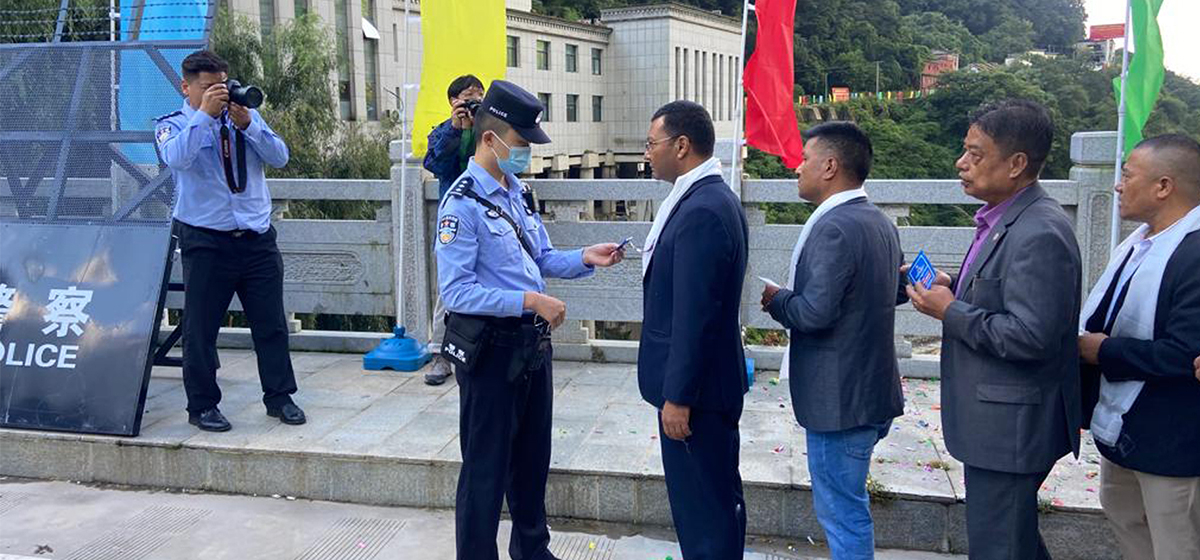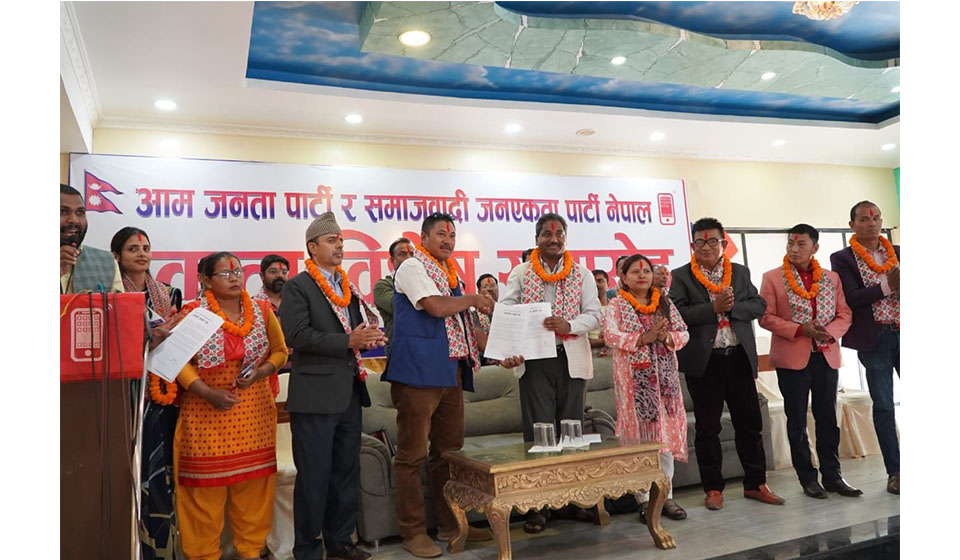
OR
Nepal-China border at Tatopani reopens after a lengthy closure of 8.5 years
Published On: September 1, 2023 07:31 PM NPT By: DHRUBA DANGAL

227 locals get entry pass
KATHMANDU, Sept 1: The primary Tatopani border crossing connecting Nepal and China has finally reopened to the public after a lengthy closure of eight and a half years. As of now, the border crossing is accessible to residents of Sindhupalchowk, and this long-awaited border reopening for human traffic commenced on Friday.
In the morning, a group of 30 residents from the Bhotekoshi Rural Municipality were granted permission to enter the Tibetan region via the Miteri Bridge. Chinese officials extended a warm welcome to the locals, adorning the bridge with the national flags and flagpoles of both nations, and facilitated their entry into Tibetan territory. The residents arrived at the Bilateral Border Miteri Bridge amidst jubilant cheers and colorful tableaus.
"Human movement has commenced through the gate, and we are now working to establish a systematic process," stated Rabindra Pokharel, the head of the Immigration Office in Kodari. He further said that a specific entry pass system has been put in place for those wishing to enter Chinese territory. According to him, the immigration office is responsible for issuing these entry passes. Currently, only the residents of Sindhupalchowk living within 30 kilometers of the border are eligible to receive an entry pass. As of Friday, a total of 227 local residents have been granted this pass.
The entry pass now allows individuals to enter and explore the Tibetan region, and it remains valid for one year. In the past, this pass permitted travel within a 30-kilometer radius from the local border area for citizens of both countries. However, due to the aftermath of the devastating earthquake, this border crossing, which is the closest to the capital, Kathmandu, has not fully returned to its previous operational status. Consequently, human movement remains constrained in the area.
Previously, the border had been exclusively accessible for import and export trade. In the third phase, starting from Friday, it has been opened to the public. Following the devastating earthquake on 25 April, 2015, this border remained completely closed for four and a half years. After extensive diplomatic efforts, on 29 May, 2019, the one-way border was reactivated for import trade. Four years later, on 1 May, it transitioned into two-way operation, allowing for exports as well. However, it's important to note that during this time, human traffic was not permitted, and the checkpoint was only operational with the stipulation of no human movement.
While the border has been accessible to the local public since Friday, there has been no official information provided regarding the movement of Nepali citizens and foreigners. Prior to the earthquake, Nepali citizens could enter Tibet with a one-day pass issued by the Immigration Office, based on their citizenship certificate or passport. Foreign nationals used to travel freely between Nepal and China through this border. For foreigners arriving in Nepal through this crossing, the Immigration Office would extend their entry visa for a brief period. Nepali officials have mentioned that the details of the complete movement of Nepali citizens and foreigners will become clearer over time.
Chinese officials have shared that they have initiated the operation of 30 shops in the Tibetan areas of Ramit and Khasa, situated across the Miteri Bridge. This decision has been made with the local population and human movement in mind. These shops are equipped to provide a range of household items and clothing to cater to the needs of the local residents and visitors.
Following the earthquake, the Khasa market in Tibet remained abandoned for an extended period, but it has seen resurgence with the presence of some Chinese residents. Chinese officials have indicated that efforts are underway to reconstruct the Khasa Bazaar. It is hoped that once this reconstruction is completed, human traffic in the area will gradually return to normal, revitalizing economic activities and trade at the border.
You May Like This

Sunkoshi-Marin Diversion Project’s tunnel construction nears completion, breakthrough scheduled for May 8
KATHMANDU, April 27: The construction of the tunnel of the Sunkoshi Marin Diversion Multipurpose Project, which is a project of... Read More...

Govt tightens security arrangement for Third Investment Summit 2024
KATHMANDU, April 27: The government has tightened the security arrangements for the Third Investment Summit 2024. Security arrangements have been... Read More...

1,600 participants confirmed for Nepal Investment Summit
KATHMANDU, April 27: The government has confirmed participation of over 1,600 people for the third Nepal Investment Summit, commencing on... Read More...


Just In
- Sunkoshi-Marin Diversion Project’s tunnel construction nears completion, breakthrough scheduled for May 8
- Govt tightens security arrangement for Third Investment Summit 2024
- Pesticide residue found in vegetables in Nepalgunj
- Aam Janata Party and Samajwadi Jana Ekata Party merge
- 1,600 participants confirmed for Nepal Investment Summit
- Ilam-2 by-elections held peacefully, vote count likely to start tonight
- NEA schedules five-day power cut across Kathmandu Valley for underground cable installation
- Hundreds of passengers including foreign tourists in distress as poor visibility halts flights to and from PRIA







-1200x560-wm_20240427144118.jpg)






Leave A Comment